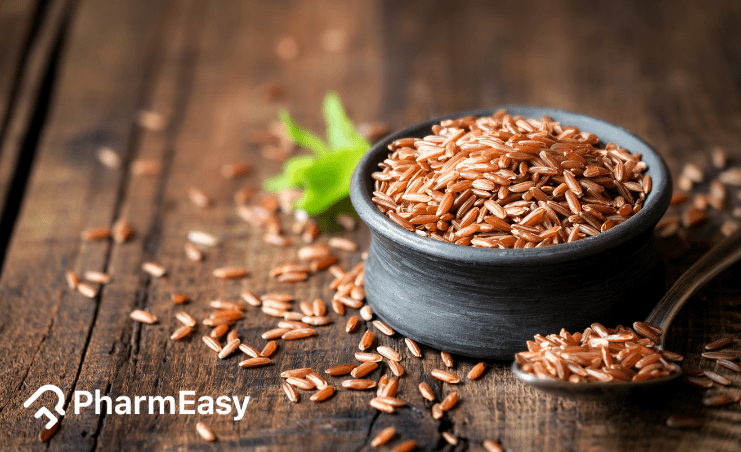Red rice: Uses, Benefits, Side effects and More By Dr. Rajeev Singh
By Dr Rajeev Singh +2 more

Download PharmEasy App




Register to Avail the Offer
Send OTPBy continuing, you agree with our Privacy Policy and Terms and Conditions
By Dr Rajeev Singh +2 more
Table of Contents
In Balinese mythology, it is believed that God sent a bird to earth with four seeds which were red, white, black and yellow. On its way, the bird ate the yellow seed and only three coloured seeds were left. These three coloured seeds, namely white, black and red, were the different rice grains to date. In comparison with white rice, red rice is rich in zinc, iron, etc. Red rice is also known as Oryza longistaminata, Matta rice, Palakkadan Matta rice and Rakthashali in Ayurveda. It has an eye-grabbing color due to an antioxidant called anthocyanin. It can be partially or fully covered with husk. Red rice can be seen in weedy, wild and cultivated types. Red rice has been cultivated in Sri Lanka, China, the United States, Korea and India. In India, it is widely grown in Karnataka, Tamil Nadu, Kerala, Orissa and Madhya Pradesh. Some famous red rice varieties include Patni of Maharashtra, Matali and Jatu of Kullu and Matta of Kerala. Let us dig into red rice’s health benefits, side effects and nutritional facts.1

Did you know?
Red rice is a nutritional powerhouse, packed with the goodness of proteins, carbohydrates, mono-unsaturated fatty acids, vitamins and minerals like zinc, iron, and polyphenols like vanillic acid, ferulic acid, etc. Antioxidants like anthocyanins, proanthocyanidins, flavonoids and lipids like gamma-oryzanol, etc. The nutritional components of red rice are given in the table below:
| Nutritional components | Value per 100 g |
| Energy | 356 kCal |
| Fibre | 11.10 g |
| Protein | 8.89 g |
| Fats | 3.33 g |
| Potassium | 156 mg |
| Sodium | 67.0 mg |
| Zinc | 30.0 mg |
| Iron | 1.11 mg |
Table 1: Nutritional value of red rice2
The consumption of red rice shows numerous scientifically proven properties; some of these properties are mentioned below:
Based on some research, I will recommend the consumption of red rice to patients with osteoporosis. These studies suggest that red yeast rice might promote bone formation and might aid in the treatment of osteoporosis.
Dr. Siddharth Gupta, MD
Some of the potential benefits of red rice are described as under:
Inflammation is a defensive action of the body against infection, stress and tissue injury. Inflammation can be acute as in fever or chronic as seen in arthritis. Limtrakul et al. conducted a systematic review in 2016 stating that red rice exerts anti-inflammatory and antioxidant effects. Here, antioxidants protect the cells from damage and reduce inflammation. These effects are due to phytochemicals like gamma-oryzanol, flavonoids, phenols, etc. This indicates that consuming red rice may help manage inflammatory diseases like arthritis, etc. However, there are no studies to support these claims, and we need more scientific evidence to support these claims.5
Breast cancer is the most common cancer affecting women worldwide. Pintha et al. conducted a study in 2015 to assess the effects of red rice on breast cancer. The results of this study showed that red rice may stop the growth of cancer cells by inhibiting a protein, IL-6, which promotes the growth of cancer cells. Additionally, it inhibits the movement of cancer cells (metastasis) to other parts of the body. These effects are attributed to the presence of polyphenols like proanthocyanidins. This indicates that red rice may help reduce the risk of breast cancer. However, we need more clinical trials to support these claims with greater reliability.6
Alopecia is the loss of hair or baldness. Red rice is high in proteins and may help with hair growth. Jeng et al. conducted a study in 2012 to assess the effect of red rice on hair. The findings of this study showed that red rice inhibits the enzyme 5-alpha reductase and reduces hair loss. The results of this study indicate that red rice may improve hair growth and manage alopecia. However, we need more scientific evidence to support the use of red rice for managing alopecia.7
Type 2 diabetes is characterized by elevated blood glucose levels either due to a decreased insulin level or resistance of the body to insulin (a hormone that regulates blood glucose levels). Yagi et al. conducted a study in 2020 to assess the effects of red rice in a diabetic mouse model. The results of this study support the use of red rice for managing diabetes. The anti-diabetic effect is attributed to the low glycemic index of red rice and increased insulin sensitivity. This indicates that red rice may positively impact type 2 diabetes. However, more human clinical trials are needed to ascertain these claims in humans.8
Dyslipidemia is characterized by elevated cholesterol, increased low-density lipoprotein or bad cholesterol, and a low high-density lipoprotein or good cholesterol. A review by Shariq et al. in 2013 Stated that red yeast rice (fermented red rice) helps lower cholesterol by inhibiting its synthesis. Additionally, the presence of phytosterols and mono-unsaturated fatty acids in red rice may help in managing dyslipidemia. This indicates that red rice may positively impact dyslipidemia. However, more studies are needed to support these claims with greater reliability.9
Literature studies state that diets rich in fibre are associated with a decreased consumption of fats and may improve digestion. A review done by Betheda et al. in 2019 stated that red rice was used in traditional Chinese medicine to aid digestion. Being a good source of dietary fibre, red rice may help in improving bowel movements and providing relief from constipation. Additionally, red rice is low in fat content and high in protein and fibre; it increases satiety, reduces overeating and may help in better metabolism. This indicates that its consumption may aid the digestive process, relieve constipation and help in weight loss.10, 11
Though there are studies that show the benefits of red rice in various conditions, these are insufficient and there is a need for further studies to establish the true extent of the benefits of Red rice on human health.
As red rice is a good source of many nutrients, including phytochemicals, these phytochemicals might have anti-ageing properties, which may be beneficial for the skin.
Dr. Rajeev Singh, BAMS
Also Read: Is Risotto Gluten Free? Unveiling the Facts Behind Your Favorite Dishes
You must consult a qualified doctor before taking any herbal supplements. Do not discontinue or replace an ongoing treatment of modern medicine with an ayurvedic/herbal preparation without consulting a qualified doctor.
Also Read: Does Rice Have Gluten? Dispelling Dietary Myths
Few side effects related to the consumption of red rice include:
However, if you experience any adverse reactions to red rice, it is advised to discontinue its intake and immediately contact a doctor or your Ayurvedic physician who has prescribed it. They will be able to guide you appropriately for your symptoms.
Eating red rice is okay if taken in moderate amounts. However, general precautions must be followed in the following conditions:
Therefore, you must always seek the advice of your Ayurvedic physician about the possible interaction of red rice with other drugs and follow the prescription thoroughly, as they will know your health condition and other medications you are taking.
Also Read: Purple Rice: Uses, Benefits, Side Effects & More
Red rice is also known as Oryza longistaminata, Matta rice, Palakkadan Matta rice, and Rakthashali in Ayurveda.1
Yes. In comparison with white rice, red rice is rich in zinc, iron, etc. and has several health benefits as discussed above.1
Some famous red rice varieties include Patni of Maharashtra, Matali and Jatu of Kullu, and Matta of Kerala.1
Yes. Red rice is low in fat and high in protein and fibres, which is why it increases satiety and reduces overeating and may help in weight loss.10
Gabriela et al. in 2017 stated that if red rice is fermented and use, it may cause liver injuries. Excessive consumption of red rice can result in indigestion, bloating and stomach pain due to the presence of high amount of fibres and protein. Red rice consumption does not cause allergy, but can sometimes result in itching, rashes and swelling. The exact cause and mechanism behind this is not fully understood.10, 11
Disclaimer: The information provided here is for educational/awareness purposes only and is not intended to be a substitute for medical treatment by a healthcare professional and should not be relied upon to diagnose or treat any medical condition. The reader should consult a registered medical practitioner to determine the appropriateness of the information and before consuming any medication. PharmEasy does not provide any guarantee or warranty (express or implied) regarding the accuracy, adequacy, completeness, legality, reliability or usefulness of the information; and disclaims any liability arising thereof.
Links and product recommendations in the information provided here are advertisements of third-party products available on the website. PharmEasy does not make any representation on the accuracy or suitability of such products/services. Advertisements do not influence the editorial decisions or content. The information in this blog is subject to change without notice. The authors and administrators reserve the right to modify, add, or remove content without notification. It is your responsibility to review this disclaimer regularly for any changes.
Comments